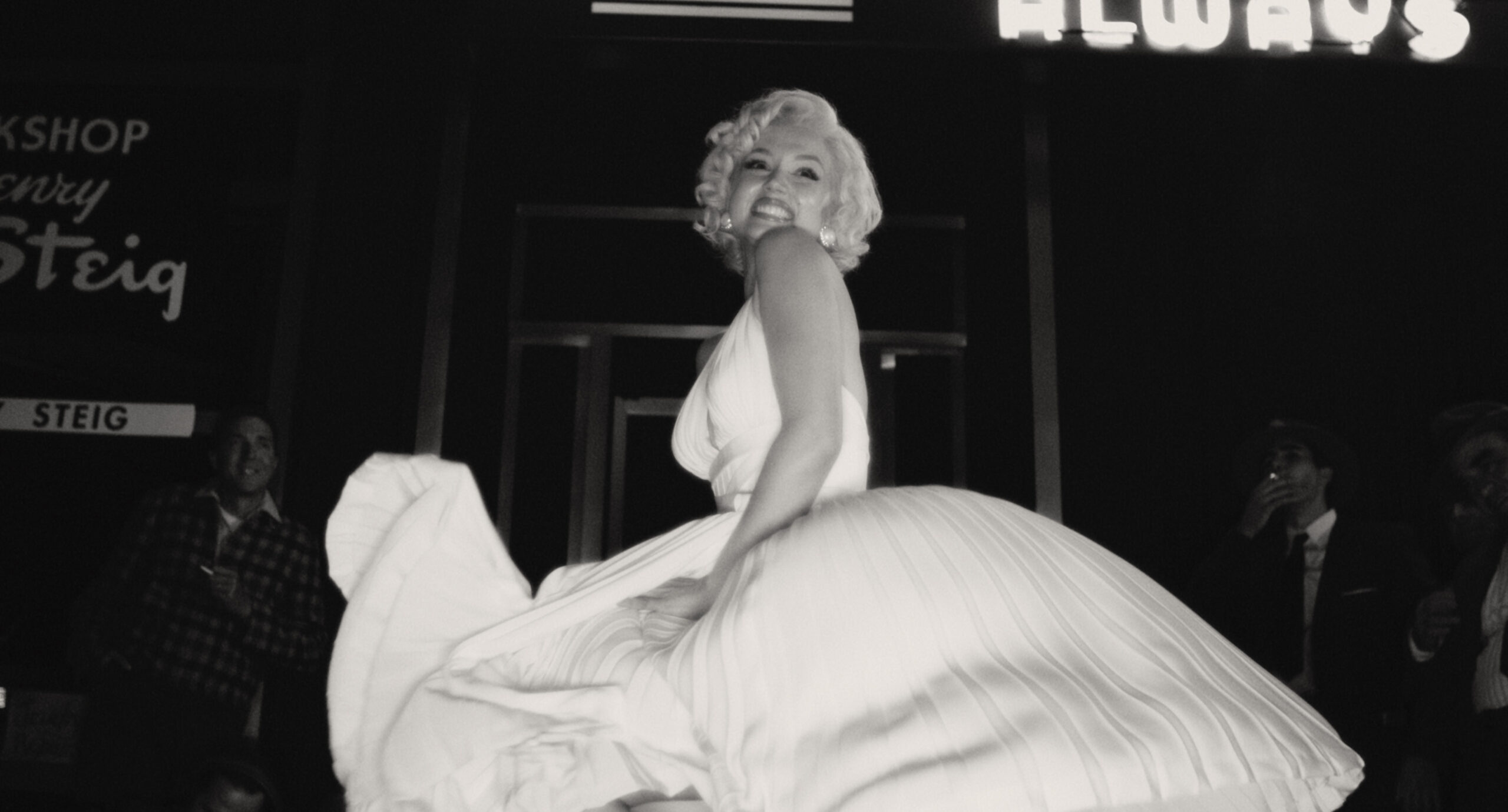
Is it ethical to tell a made-up story about a real person? What if the story doesn’t present the real person in a positive way? What if it uses that person as a mirror to interrogate the audience about the stories we tell about that person?
How you answers those questions will help you determine whether or not to watch Blonde, Andrew Dominik’s new film based on Joyce Carol Oates’ novel which presents a fictional account of Marilyn Monroe’s life. If you think the woman we know as Marilyn Monroe (who’s real name was Norma Jean Mortenson) should only be presented accurately and positively, Blonde is not for you. If, on the other hand, you are okay with a fictional portrayal of the pop culture icon and game for an investigation of what she means to the culture at large, then you might appreciate Blonde.
Blonde is most like The Passion of the Christ, Spielberg’s Lincoln, or The Passion of Joan of Arc. The film follows Marilyn (Ana de Armas, who likely knows a thing or two about being a starlet, handling a tricky role with much dexterity) through a period of her life—in this case, her whole life—as she endures trial and tribulation. It ends in her death. As she is not a religious or political figure, her accusers and abusers are not political authorities but the public and her peers in the entertainment industry. As the subjects of those other films do, Marilyn obtains sainthood, or a kind of pop culture divinity, through her trials.
Blonde takes the audience on a parade of horrors. Presented in a mix of black and white and color and visually restless, the film is highly stylized. Key moments from Marilyn’s life are captured in chiaroscuro, like tabloid stations of the cross. The film stays with these moments for a long time which creates space for the audience’s emotional response to morph and modulate as we reflect on the image. These are not pleasant images. The things we feel are not pleasant either.
You may note that Blonde is rated NC-17, a designation that suggests the material is more “adult” than even R-rated films. The film is indeed sexually graphic. The film features rape, nudity, and explicit sexual acts. I have seen equally graphic sexual scene in R-rated films, but those are usually single scenes in a film. In Blonde, the scenes featuring explicit sexuality comprise the film.
We should expect this – Marilyn Monroe is pop culture’s patron saint of sex. Onto her image we cast our beliefs about desire, erotic power, and exploitation. Blonde confronts us with our idolization. Unlike those films I mentioned previously which Blonde is most like, Blonde is not an invitation to further reverence. It is an excavation of Marilyn’s adherents’ devotion. For its tone and effect, the NC-17 rating is appropriate. (For what it’s worth, I think The Passion of the Christ should be rated NC-17 as well. It is the most graphically violent film I have ever seen, but American culture reckons graphic physical violence differently than we do graphic sexuality.)
Blonde is a work of deconstruction. Deconstruction is an unpleasant experience. So is Blonde. I don’t recommend anyone go through a process of deconstruction without a guide. Blonde isn’t a guide. It is the work itself. It is an aesthetically provocative deconstruction of our culture’s conceptions of Marilyn Monroe, of society’s willingness to sacrifice people on the alter of celebrity and consumerism, a theme that is common throughout Andrew Dominik’s rare work. It is for people who are interested in also doing that work. I can’t imagine there are very many of them.
Is it ethical to tell a made-up story about a real person? What if the story doesn’t present the real person in a positive way? What if it uses that person as a mirror to interrogate the audience about the stories we tell about that person?
How you answers those questions will help you determine whether or not to watch Blonde, Andrew Dominik’s new film based on Joyce Carol Oates’ novel which presents a fictional account of Marilyn Monroe’s life. If you think the woman we know as Marilyn Monroe (who’s real name was Norma Jean Mortenson) should only be presented accurately and positively, Blonde is not for you. If, on the other hand, you are okay with a fictional portrayal of the pop culture icon and game for an investigation of what she means to the culture at large, then you might appreciate Blonde.
Blonde is most like The Passion of the Christ, Spielberg’s Lincoln, or The Passion of Joan of Arc. The film follows Marilyn (Ana de Armas, who likely knows a thing or two about being a starlet, handling a tricky role with much dexterity) through a period of her life—in this case, her whole life—as she endures trial and tribulation. It ends in her death. As she is not a religious or political figure, her accusers and abusers are not political authorities but the public and her peers in the entertainment industry. As the subjects of those other films do, Marilyn obtains sainthood, or a kind of pop culture divinity, through her trials.
Blonde takes the audience on a parade of horrors. Presented in a mix of black and white and color and visually restless, the film is highly stylized. Key moments from Marilyn’s life are captured in chiaroscuro, like tabloid stations of the cross. The film stays with these moments for a long time which creates space for the audience’s emotional response to morph and modulate as we reflect on the image. These are not pleasant images. The things we feel are not pleasant either.
You may note that Blonde is rated NC-17, a designation that suggests the material is more “adult” than even R-rated films. The film is indeed sexually graphic. The film features rape, nudity, and explicit sexual acts. I have seen equally graphic sexual scene in R-rated films, but those are usually single scenes in a film. In Blonde, the scenes featuring explicit sexuality comprise the film.
We should expect this – Marilyn Monroe is pop culture’s patron saint of sex. Onto her image we cast our beliefs about desire, erotic power, and exploitation. Blonde confronts us with our idolization. Unlike those films I mentioned previously which Blonde is most like, Blonde is not an invitation to further reverence. It is an excavation of Marilyn’s adherents’ devotion. For its tone and effect, the NC-17 rating is appropriate. (For what it’s worth, I think The Passion of the Christ should be rated NC-17 as well. It is the most graphically violent film I have ever seen, but American culture reckons graphic physical violence differently than we do graphic sexuality.)
Blonde is a work of deconstruction. Deconstruction is an unpleasant experience. So is Blonde. I don’t recommend anyone go through a process of deconstruction without a guide. Blonde isn’t a guide. It is the work itself. It is an aesthetically provocative deconstruction of our culture’s conceptions of Marilyn Monroe, of society’s willingness to sacrifice people on the alter of celebrity and consumerism, a theme that is common throughout Andrew Dominik’s rare work. It is for people who are interested in also doing that work. I can’t imagine there are very many of them.

Elijah Davidson is Co-Director of Brehm Film and Senior Film Critic. Subscribe to his weekly email series that guides you through film history, Come & See, and find more of his work at elijahdavidson.com.
Top Gun: Maverick isn’t a movie. It’s music. It’s the kind of story sung by ancient Greek poets who beseech the Muses for inspiration.